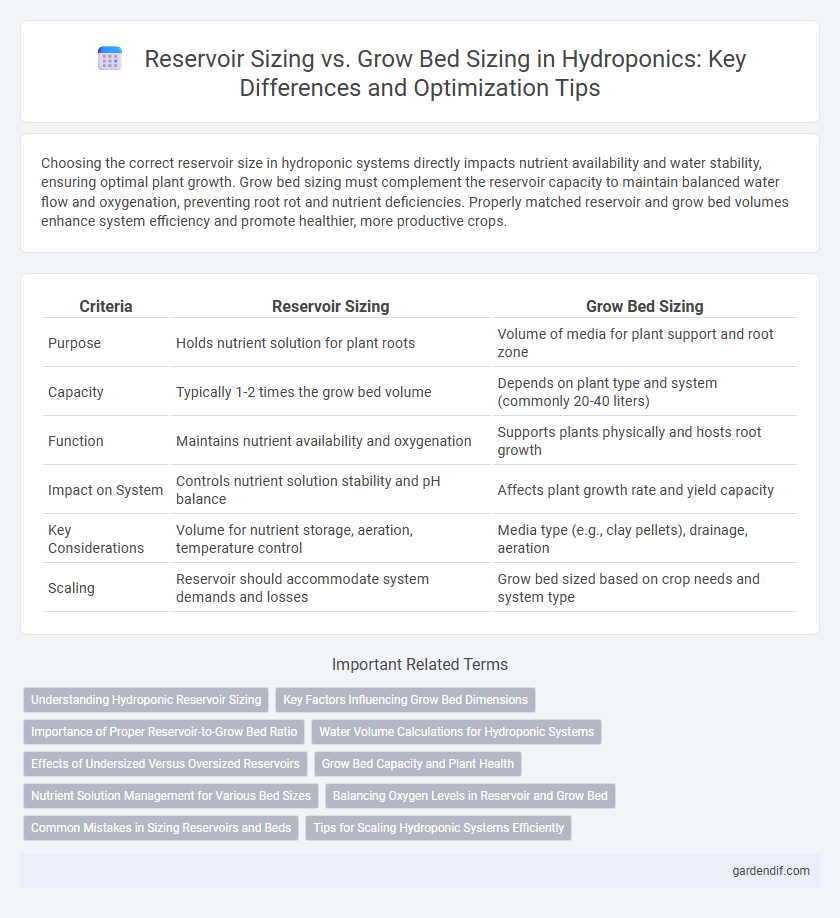
Reservoir Sizing vs Grow Bed Sizing Illustration
Choosing the correct reservoir size in hydroponic systems directly impacts nutrient availability and water stability, ensuring optimal plant growth. Grow bed sizing must complement the reservoir capacity to maintain balanced water flow and oxygenation, preventing root rot and nutrient deficiencies. Properly matched reservoir and grow bed volumes enhance system efficiency and promote healthier, more productive crops.
Table of Comparison
| Criteria | Reservoir Sizing | Grow Bed Sizing |
|---|---|---|
| Purpose | Holds nutrient solution for plant roots | Volume of media for plant support and root zone |
| Capacity | Typically 1-2 times the grow bed volume | Depends on plant type and system (commonly 20-40 liters) |
| Function | Maintains nutrient availability and oxygenation | Supports plants physically and hosts root growth |
| Impact on System | Controls nutrient solution stability and pH balance | Affects plant growth rate and yield capacity |
| Key Considerations | Volume for nutrient storage, aeration, temperature control | Media type (e.g., clay pellets), drainage, aeration |
| Scaling | Reservoir should accommodate system demands and losses | Grow bed sized based on crop needs and system type |
Understanding Hydroponic Reservoir Sizing
Proper hydroponic reservoir sizing is critical to maintaining nutrient balance and oxygen availability for plant roots, directly influencing growth rates and crop yield. The reservoir should typically hold at least three to five times the volume of the grow bed to ensure adequate nutrient solution circulation and prevent rapid depletion or temperature fluctuations. Understanding the relationship between reservoir capacity and grow bed size helps optimize system efficiency and supports stable hydroponic nutrient delivery.
Key Factors Influencing Grow Bed Dimensions
Key factors influencing grow bed dimensions in hydroponic systems include the type of crop being cultivated, water and nutrient requirements, and the overall system design. Proper reservoir sizing ensures consistent nutrient solution availability, whereas grow bed size must accommodate root growth and oxygen diffusion effectively. Optimizing grow bed dimensions improves plant health, nutrient uptake efficiency, and system sustainability.
Importance of Proper Reservoir-to-Grow Bed Ratio
Proper reservoir-to-grow bed ratio is crucial for maintaining nutrient solution stability and ensuring optimal plant growth in hydroponic systems. A commonly recommended ratio ranges from 1:1 to 1:3 (reservoir volume to grow bed volume) to prevent rapid depletion of water and nutrients while providing adequate oxygenation. Incorrect sizing can lead to nutrient imbalances, root stress, and reduced crop yields, emphasizing the need for careful reservoir and grow bed volume calculations.
Water Volume Calculations for Hydroponic Systems
Accurate reservoir sizing in hydroponic systems ensures optimal water volume to sustain plant growth without causing nutrient imbalances or oxygen depletion. Grow bed sizing directly influences water retention and circulation rates, affecting the total system's hydraulic capacity. Calculating water volume involves assessing plant water uptake, media porosity, and system cycle time to balance reservoir capacity with grow bed dimensions for efficient nutrient delivery and root oxygenation.
Effects of Undersized Versus Oversized Reservoirs
Undersized reservoirs in hydroponic systems cause frequent water temperature fluctuations and nutrient imbalances, stressing plant roots and reducing growth rates. Oversized reservoirs lead to stagnant water zones, promoting algae growth and inefficient nutrient utilization, which can impair plant health. Optimal reservoir sizing relative to grow bed volume ensures stable nutrient delivery and oxygenation, maximizing yield and system efficiency.
Grow Bed Capacity and Plant Health
Grow bed capacity directly influences plant health by regulating nutrient availability and root oxygenation within the hydroponic system. Properly sized grow beds provide sufficient space for root expansion, preventing overcrowding and ensuring optimal nutrient uptake. Balancing grow bed volume with reservoir size maintains stable water quality and supports robust plant growth.
Nutrient Solution Management for Various Bed Sizes
Proper reservoir sizing is crucial to maintaining optimal nutrient solution levels and stability in hydroponic systems, especially when paired with varying grow bed sizes. Oversized reservoirs reduce nutrient concentration fluctuations, ensuring consistent delivery across larger grow beds, while undersized tanks risk rapid nutrient depletion and pH imbalances. Balancing reservoir volume with grow bed surface area and plant density enhances nutrient uptake efficiency and supports sustained crop growth.
Balancing Oxygen Levels in Reservoir and Grow Bed
Proper reservoir sizing in hydroponic systems is critical to maintaining optimal dissolved oxygen levels, which directly impact root health and nutrient uptake in the grow bed. Balancing the volume of water in the reservoir with the surface area and media depth of the grow bed ensures efficient oxygen diffusion and prevents stagnation that can lead to root diseases. Adequate oxygenation can be achieved by aligning reservoir capacity with grow bed dimensions, promoting aerobic conditions essential for robust plant growth.
Common Mistakes in Sizing Reservoirs and Beds
In hydroponic systems, incorrect reservoir sizing often leads to inadequate nutrient availability and oxygenation, stunting plant growth. Oversizing grow beds compared to reservoirs results in poor water circulation and nutrient depletion, causing root stress and reduced yield. Balancing reservoir volume with grow bed capacity ensures optimal nutrient delivery, oxygen levels, and system efficiency for healthy plant development.
Tips for Scaling Hydroponic Systems Efficiently
Optimizing reservoir sizing relative to grow bed volume is essential for maintaining nutrient balance and system stability in hydroponic setups. A common recommendation is to use a reservoir capacity that is at least 50% of the total grow bed volume to prevent nutrient concentration fluctuations and ensure consistent oxygenation. Efficient scaling also involves modular design strategies and real-time monitoring tools to adapt reservoir and grow bed sizes dynamically as the system expands.
Reservoir Sizing vs Grow Bed Sizing Infographic

 gardendif.com
gardendif.com